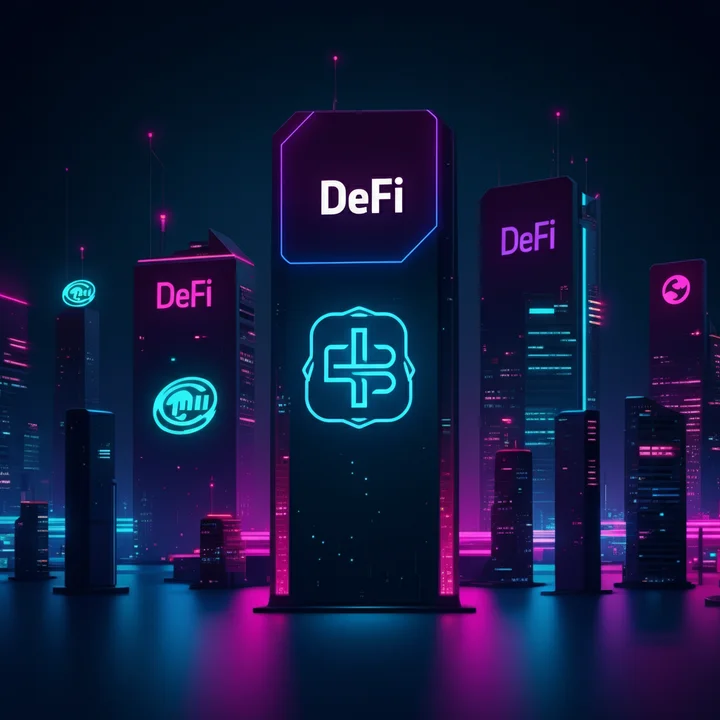Are you hearing the term "DeFi" tossed around lately and wondering what it’s all about? Short for decentralized finance, DeFi is one of the hottest buzzwords in the financial and tech world. But don’t worry if you’re not familiar yet—we’ve got you covered.
This guide breaks down DeFi, explains how it’s reshaping traditional finance, introduces its key components, and walks you through the basics to get started safely.
By the end of this article, you’ll have a solid understanding of DeFi and an idea of whether it’s something you want to explore.
What Is DeFi?
DeFi, or decentralized finance, refers to a new financial system built on public blockchains like Ethereum. Unlike traditional financial institutions like banks and payment processors, DeFi applications operate without intermediaries. Instead, they use smart contracts (self-executing agreements coded on a blockchain) to automate transactions.
At its core, DeFi empowers individuals to access financial services directly, from borrowing and lending to trading and investing, without relying on centralized authorities. Think of it as a digital, decentralized alternative to the conventional financial system.
DeFi’s Purpose
The main goal of DeFi is to make finance more inclusive, transparent, and efficient. With just an internet connection, anyone from around the world can access DeFi services, eliminating barriers posed by geography, bias, or bureaucracy within traditional finance systems.
But how exactly does it differ from traditional finance? Let's explore.
DeFi vs. Traditional Finance
DeFi and traditional finance differ in several fundamental ways.
1. Decentralization: Traditional finance relies on centralized authorities (banks, governments) to approve and oversee transactions. DeFi, on the other hand, uses blockchain technology to remove the middleman.
2. Global Accessibility: Traditional financial systems often exclude over 1.4 billion adults globally who lack access to banking services. With DeFi, anyone with an internet connection can participate.
3. Transparency: DeFi operates on public blockchains, meaning anyone can audit transactions and data, enhancing trust. Traditional systems lack this level of transparency.
4. Control: DeFi users retain full ownership of their funds. Traditional finance typically hands control over to institutions managing your money.
Now that we understand the basics, it’s time to look at the building blocks that make DeFi possible.
Key Components of DeFi
DeFi comprises several fundamental components that enable its unique ecosystem. Here are the most notable ones:
1. Decentralized Exchanges (DEXs)
DEXs like Uniswap and SushiSwap are platforms that enable users to trade cryptocurrencies without the need for a centralized intermediary. Unlike traditional stock markets or crypto exchanges such as Binance or Coinbase, DEXs give users complete control over their assets via digital wallets.
How they work: Smart contracts automatically match buyers and sellers, while liquidity pools (more on these later) ensure there’s enough inventory for trades.
Pros: Greater privacy and no KYC (Know Your Customer) requirements.
Cons: Not as user-friendly as centralized exchanges and may involve higher risks, such as impermanent loss.
2. Lending & Borrowing Platforms
DeFi platforms like Aave, Compound, and MakerDAO allow users to lend their cryptocurrencies and earn interest or borrow against their crypto holdings without needing traditional credit checks.
How it works: Borrowers provide collateral in crypto to secure a loan, while lenders deposit funds into smart contract-controlled pools and earn interest.
Pros: Access to quick funding and passive income opportunities.
Cons: Volatility in market prices can impact collateralized loans, causing liquidations.
3. Stablecoins
Stablecoins are a type of cryptocurrency designed to maintain a stable value, often pegged to fiat currencies like the USD. Popular examples include USDT (Tether) and DAI (a decentralized stablecoin by MakerDAO).
Why they matter: They minimize volatility and act as a secure medium of exchange within DeFi ecosystems.
Pros: Stability, making them a good alternative for conducting everyday transactions.
4. Yield Farming & Liquidity Pools
Yield farming involves users providing liquidity to DeFi protocols by depositing their cryptocurrencies into liquidity pools. These pools power decentralized exchanges and lending platforms.
Rewards: Farmers earn interest, fees, or tokens as rewards for supplying liquidity.
Risks: High returns come with risks such as impermanent loss and smart contract vulnerabilities.
Now that we’ve covered the components, let's take a look at some major players.
Popular DeFi Protocols
Here are a few DeFi platforms that have revolutionized the space and are worth knowing about:
Uniswap: A leading DEX for trading crypto directly from your wallet.
Aave: A top lending platform offering various borrowing options like flash loans.
Compound: Great for lending and earning interest on deposits.
Yearn.Finance: An advanced protocol focused on yield farming and optimizing returns.
Each protocol has unique features tailored to specific needs, making it essential to do your research before jumping in.
Benefits of DeFi
Here are some of the standout advantages that make DeFi so revolutionary:
Accessibility: Anyone with an internet connection can participate.
Transparency: Transaction history is publicly recorded on the blockchain.
Cost Efficiency: Cut out middleman fees for financial transactions.
Full Control: Users manage their own funds without relying on third parties.
Despite the positives, it’s not all sunshine and rainbows. DeFi comes with some inherent risks that should be acknowledged.
Risks of DeFi
1. Smart Contract Bugs
Smart contracts are prone to vulnerabilities in their code. If exploited, they can lead to millions in losses.
2. Volatility
The value of cryptocurrencies and assets within DeFi ecosystems can change drastically, potentially impacting investments.
3. Impermanent Loss
Yield farming participants risk impermanent loss when the value of supplied tokens fluctuates significantly.
4. Regulatory Uncertainty
With limited regulation, participants face risks related to security, penalties, or frozen funds.
Now that you know the pros and cons, it’s time to explore how to dip your toes safely into DeFi.
Getting Started with DeFi Safely
Although DeFi’s benefits are exciting, it pays to approach cautiously. Here are some tips to get you started safely:
Educate Yourself First: Understand the tech behind DeFi and familiarize yourself with popular protocols.
Start Small: Begin with small amounts of money that you can afford to lose.
Use Trusted Platforms: Stick to well-known protocols with a proven track record.
Secure Your Wallet: Invest in a secure crypto wallet, like hardware wallets (e.g., Ledger or Trezor).
Stay Updated: Follow DeFi communities on Twitter or Discord to stay informed.
By starting safely, you can explore DeFi’s immense potential without undue risks.
Explore the Future of Finance
Decentralized finance is reshaping how we think about money and its accessibility. With its incredible potential in efficiency, transparency, and inclusivity, the possibilities are endless.
Whether you’re curious to explore DeFi or actively want to build wealth in this ecosystem, now is a great time to get started. Armed with knowledge and cautious steps, you can confidently participate in this financial revolution.
Interested in learning more? Explore leading DeFi platforms like Aave or Uniswap, or stay tuned for updates on our blog to keep up with the latest in decentralized finance.



